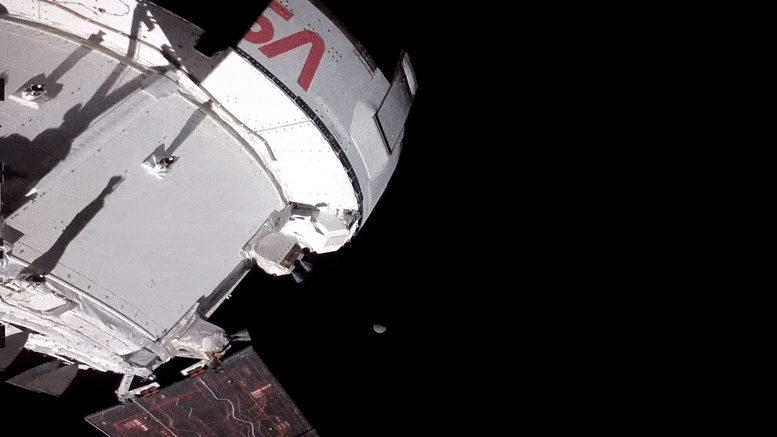On the third day of the Artemis I mission, Orion maneuvered its solar arrays and captured the Moon with a camera mounted on the end of the array. The spacecraft is now halfway to the Moon. Credit: NASA
On the third day of its Artemis I journey, NASA’s uncrewed Orion spacecraft is now more than halfway to the Moon.
“Today, we met to review the Orion spacecraft performance, and it is exceeding performance expectations,” said Mike Sarafin, Artemis I mission manager.
Flight controllers used Orion’s cameras on Friday to inspect the crew module thermal protection system and European Service Module. This was the first of two planned external evaluations for the spacecraft. Teams conducted this survey early in the mission to provide detailed images of the spacecraft’s external surfaces after it has flown through the portion of Earth’s orbit where the majority of space debris resides.
The second inspection is required during the return phase to assess the overall condition of the spacecraft several days before re-entry. During both inspections, the Integrated Communications Officer, or INCO, commands cameras on the four solar array wings to take still images of the entire spacecraft, allowing experts to pinpoint any micrometeoroid or orbital debris strikes. The team in mission control at NASA’s Johnson Space Center in Houston will review the imagery following the survey.
Artemis All Access is your look at the latest in Artemis I, the people and technology behind the mission, and what is coming up next. This uncrewed flight test around the Moon will pave the way for a crewed flight test and future human lunar exploration as part of Artemis. Credit: NASA
Over the past few days, a team assessed anomalous star tracker data that correlated with thruster firings. Star trackers are sensitive cameras that take pictures of the star field around Orion. By comparing the pictures to its built-in map of stars, the star tracker can determine which way Orion is oriented. Teams now understand the readings and there are no operational changes.
NASA also has received updates from teams associated with the 10 CubeSats that were delivered to space on a ring attached to the Space Launch System rocket’s upper stage. All 10 CubeSats were successfully deployed via timer from the adapter. The CubeSats’ individual missions are separate from Artemis I. The small satellites, each about the size of a shoebox, are inherently high-risk, high-reward and the teams are in various stages of mission operations or troubleshooting in some cases.
NASA hosted a briefing (see video embedded below) on Friday previewing Orion’s arrival to the lunar sphere of influence. To follow the mission real-time, you can track Orion during its mission around the Moon and back, and check the NASA TV schedule for updates on the next televised events. The first episode of Artemis All Access is now available (see video embedded above) as a recap of the first three days of the mission with a look ahead to what’s coming next.
From NASA’s Johnson Space Center in Houston, NASA previews the Orion spacecraft’s entry into the Moon’s sphere of influence and the pair of maneuvers that will propel the spacecraft into a distant retrograde lunar orbit. Briefing participants include:
- Mike Sarafin, Artemis I mission manager, NASA Headquarters
- Jeff Radigan, flight director, NASA Johnson
- Jim Geffre, Orion vehicle integration manager, NASA Johnson
Orion’s entry into the lunar sphere of influence will make the Moon, instead of Earth, the main gravitational force acting on the spacecraft. Flight controllers will conduct an outbound powered flyby burn to harness the force from the Moon’s gravity, accelerate the spacecraft, and direct it toward a distant retrograde orbit beyond the Moon. During the outbound powered flyby, Orion will make its closest approach – approximately 80 miles – above the lunar surface. Four days later, another burn using the European Service Module will insert Orion into distant retrograde orbit, where it will remain for about a week to test spacecraft systems.
Share your story or advertise with us: Whatsapp: +2347068606071 Email: info@newspotng.com












